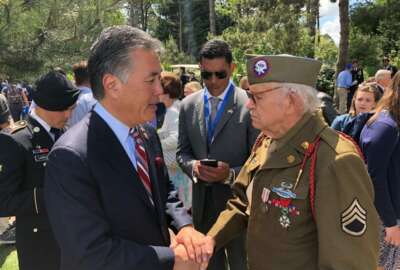

Enforced isolation of the pandemic has made a lot of people a bit lonelier. For veterans already at risk of suicide, the situation deepens the threat.
Best listening experience is on Chrome, Firefox or Safari. Subscribe to Federal Drive’s daily audio interviews on Apple Podcasts or PodcastOne.
Enforced isolation of the pandemic has made a lot of people a bit lonelier. For veterans already at risk of suicide, the situation deepens the threat. Now the Cerner Corporation, the company developing electronic health records for the Defense and Veterans Affairs departments, has launched a veterans suicide prevention initiative called LifeAid. For more, Federal Drive with Tom Temin turned to the President of Cerner Government Services Travis Dalton.
Interview transcript:
Tom Temin: Travis, good to have you on.
Travis Dalton: Hi Tom, good afternoon. Thanks for having me.
Tom Temin: Alright. Tell us about this LifeAid program. What is it? What are you doing?
Travis Dalton: Well, first of all, thanks for the opportunity to be here and to be able to share LifeAid with your listeners. LifeAid is really about igniting national conversation on how we can discuss and prevent suicide specifically in our highest risk communities, like veterans and first responders. So the initiative really is focused on three core areas. One is working on research, trying to bring public and private sector and nonprofit communities together to share best ideas and practices collectively. Solutions associated, so brain health, new protocols, treatments and approaches. And then finally, education. So LifeAid gives us a national stage to engage everyone and discuss and hopefully eradicate the stigma associated with mental health and also connect communities of support. And resources for those that are in need. And so really, what we’re trying to do is ensure that veterans and first responders can get access to treatment, information services and support that they need via this campaign.
Tom Temin: So it sounds like you’re pulling together a lot of different sources. So does this take the form of a portal, or what form does it take?
Travis Dalton: There’s several different options. So what we’ll be doing is providing national media opportunity. We’ll be providing information. We have a website that were directing people, to, which is LifeAidhope.org, that can connect and help others communicate; support therapies and services. And so it’ll be a multitude of opportunities to participate and promote the program.
Tom Temin: And I’ve noticed in a lot of programs that companies are launching to kind of help in the coronavirus pandemic period we’re in, a mash up of databases and APIs such that people can do research on the various disparate places they might not be able to access all in one place. Have you looked at that route?
Travis Dalton: Yeah, as a as a company, Cerner Corporation is at the center of health care IT and innovation. So one of the things we’re doing as a company related to COVID specifically is that we’re providing updates to our health care software. So we’re providing real time embedded intelligence alerts and documentation for care providers on the front lines. We’re also advancing telehealth solutions and the opportunity to get remote and telehealth care. And then we’re working with government agencies to aggregate data, to your point, in providing both, I’d say, aggregated data sets to review where problems may exist, but also to manage resources, for example, ventilators, pumps – other resources. We have real time data on the availability of use of those types of tools and technologies. So we’re on the front lines of working with our clients and providers related to their response to COVID-19 in supporting them as well at this time.
Tom Temin: And one of the issues in telehealth or one of the futures in it would be peripheral devices, maybe on smartphones that can transmit the kind of data that a doctor might gather on a human body that is sitting in an office. And what have you seen with respect to development of that channel? Because there are some regulatory hurdles to it, and so on, and some technical hurdles. Is that something that’s developing from your point of view?
Travis Dalton: Yeah, I think data, the use of data, the use of capability, the use of technologies will be crucial not just in our market but most major, innovative spaces. You know, data privacy is a big issue. It’s something that we take very seriously along with our clients. I think that will continue to advance the industry both in terms of the ability to get data interoperably, but also, we have to make sure that we’re providing cybersecured opportunities to do that. So we’re working on both elements, the access to data, but also the cybersecurity associated with those sources of data. That’s an important topic for our industry, collectively.
Tom Temin: We’re speaking with Travis Dalton. He’s president of Cerner Government Services, and I couldn’t have you on without asking for a quick progress report on the DoD and VA projects and I guess, for that matter, Coast Guard, which is pretty much most of the business and electronic health records in the federal government. How are you doing?
Travis Dalton: We’re pleased with our progress. As you know, we’re providing a single longitudinal record across the VA and the DoD and the Coast Guard. We’re also providing interoperable solutions for the VA and the DoD through health information exchanges. So being able to transmit and communicate with local hospitals and providers via the e-health exchange and also a network called Commonwealth. We’re pleased with our progress right now. Obviously, much of the nation, including our clients, are turning a lot of their attention to their care providers and their patients associated with COVID-19. But we’re continuing our work with the VA and the DoD. We’re working on technology. We’re working on the solution. We’re working on testing, and so we’re pleased with our progress. We’ve made good progress of DoD. We have a number of sites live. We had 20 sites scheduled for this year. And so we’re actively working with the DoD and the VA to move forward. We will have a Health Information Exchange go live toward the end of April with VA and DoD, which is a very material contribution. The VA and the DoD will now be on an interoperable Health Information Exchange Network, where they will be able to share data with each other but also share data with communities and community providers outside of the VA and DoD networks. That’s a major innovative go-live for us and the VA.
Tom Temin: Sure and VA of course, has that big legacy information system VistA programmed in M. Have you been able to import or somehow use some of that data that goes back so long? That seems like it would logically be part of this data environment.
Travis Dalton: We have. So what we’ve been able to do is take essentially 30 years worth of data from what’s called VistA, which is the current system that the VA uses today. That system is a essentially a disparate system with 130 instances or databases. What we’ve done is we’ve taken all that data. We’ve collected it in one place, and we’re in a process right now of taking those years of data and we’re aggregating it, normalizing it, and then it will be available in one place inside the electronic health record. That’s a very material development that will allow us to do some things like Data Analytics predictive modeling work with Health Registries So we’ll be able to identify chronic conditions and treat chronic conditions early and often. And then it also works back into our message with our work with LifeAid and that, you know, some things you can do related to PTSD and suicide prevention specifically, when you look at social determinants, when you look at the totality of someone’s health, you can start to predict with some decent accuracy episodic issues they may have related to PTSD and or at-risk populations for suicide and start treatments in a different way.
Tom Temin: And, of course, there’s recent clinical evidence that maybe the disposition toward that unfortunate state of mind to lead to suicide, may be a result of PTSD or it may be inherent in the person, even when they are still in DoD and enrolling and joining as a service member. So I imagine the DoD component will be important in this effort also.
Travis Dalton: This is a national epidemic in its own right – mental health issues and suicide. I’m a caregiver of someone that actually has suffered from mental health issues his entire life, who has been down this path multiple times, and it can strike anyone at any time, anywhere. And none of us, I think, are immune to knowing someone or suffering individually from issues related to mental health. And so that’s one of the reasons we’ve been so passionate about the LifeAid mission, particularly during this time when you have those that may be suffering from mental health issues that are maybe experiencing isolation or other stress associated with COVID-19 and some of the policies and procedures in the local communities. And so we thought it was important to get that message out now to make sure that they knew that they could contact the Veterans Crisis Line in the event that they’re a veteran, or go to LifeAidhope.org to get information and content. And also, again, one of things important to me is trying to really work hard to eradicate the stigma around mental health and mental health issues that still exists in many parts of the country.
Tom Temin: Travis Dalton is president of Cerner Government Services, thanks so much for joining me.
Travis Dalton: Thank you Tom, I appreciate it.
Tom Temin: We’ll post this interview at www.federalnewsnetwork.com/FederalDrive. Hear the Federal Drive on demand and on your device. Subscribe at Apple Podcasts or Podcastone. Stay up to date on your agency’s latest responses to coronavirus. Visit our special resources page at www.federalnewsnetwork.com
Copyright © 2025 Federal News Network. All rights reserved. This website is not intended for users located within the European Economic Area.
Tom Temin is host of the Federal Drive and has been providing insight on federal technology and management issues for more than 30 years.
Follow @tteminWFED


